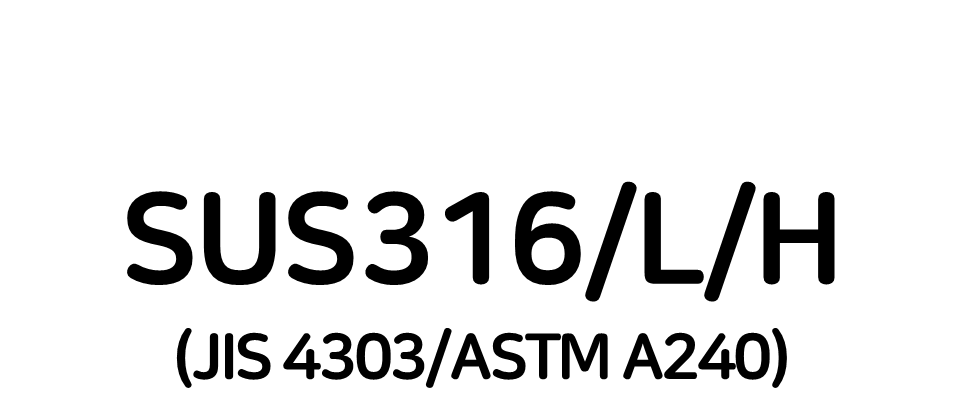Comparison of SUS316/L/H: Chemical Composition, Mechanical Properties, Characteristics, and Applications
SUS316 Series Stainless Steel: A Specialized Choice for High-Temperature and Corrosion Resistance
The SUS316 (STS) series stainless steel is widely used in various industries due to its excellent corrosion resistance and stability in high-temperature environments. Although SUS316, SUS316L, and SUS316H belong to the same series, slight differences between them lead to variations in their applications. In this post, we will compare the chemical composition and mechanical properties of these three types of SUS316 stainless steel and examine their characteristics and differences in detail.
Chemical Composition Comparison (JIS Standard)
% | SUS316 | SUS316L | SUS316H |
C | ≤0.08% | ≤0.03% | 0.01-0.10% |
MN | ≤2.00% | ≤2.00% | ≤2.00% |
Si | ≤1.00% | ≤1.00% | ≤1.00% |
Cr | 16.00~18.00% | 16.00~18.00% | 16.00~18.00% |
Ni | 10.00~14.00% | 10.00~14.00% | 10.00~14.00% |
Mo | 2.00~3.00% | 2.00~3.00% | 2.00~3.00% |
P | ≤0.045% | ≤0.045% | ≤0.045% |
S | ≤0.030% | ≤0.030% | ≤0.030% |
Key Differences:
- 316L has a low carbon content (maximum 0.03%), enhancing corrosion resistance after welding.
- 316H has a high carbon content (0.04–0.10%), improving strength in high-temperature environments.
Mechanical Properties Comparison
Properties | SUS316 | SUS316L | SUS316H |
Tensile Strength(Mpa) | ≥520 | ≥480 | ≥520 |
Yield Strength(Mpa) | ≥205 | ≥175 | ≥205 |
Elongation(%) | ≥40 | ≥40 | ≥40 |
Hardness(HB) | ≤187 | ≤187 | ≤187 |
Key Differences:
- 316L has slightly lower tensile and yield strength, but the elongation remains the same.
- 316H maintains its strength even at high temperatures.
Characteristics and Applications
# SUS316: Characteristics and Applications
Stainless steel 316 is an austenitic stainless steel of the chromium-nickel-molybdenum series, providing excellent corrosion resistance. It performs exceptionally well in highly corrosive environments such as marine conditions, saltwater, and sulfuric acid. With a high molybdenum content, it offers strong resistance to chloride ion corrosion and maintains stable performance even in high-temperature conditions.
Characteristics:
- Excellent corrosion resistance: Outstanding resistance to seawater and chemical agents.
- High-temperature stability: Maintains mechanical properties even at high temperatures.
- Good weldability: Maintains corrosion resistance even after complex welding processes.
Major Applications:
- Marine structures: Pipelines and structures requiring strong corrosion resistance to saltwater.
- Chemical equipment: Equipment handling corrosive substances such as acids and alkalis.
- Pulp and paper industry: Machinery used in corrosive environments for pulp and paper production.
- Seawater plants: Facilities related to seawater, marine power plants, and desalination equipment.
# SUS316L: Characteristics and Applications
SUS316L (Low Carbon Version) is a low-carbon stainless steel variant of 316, designed to prevent intergranular corrosion after welding. It maintains excellent corrosion resistance even after welding and performs well in low-temperature environments. The low carbon content prevents carbide formation even when exposed to high temperatures for extended periods, further enhancing corrosion resistance.
Characteristics:
- Low carbon (maximum 0.03%): High resistance to intergranular corrosion after welding.
- Stable in low-temperature environments: Less susceptible to brittleness in low temperatures.
- Excellent weldability: Provides better corrosion resistance in complex welding applications.
Major Applications:
- Chemical plants: Piping, tanks, and reactors used in chemical processes.
- Piping systems: Pipelines transporting corrosive substances.
- Food and pharmaceutical industries: Equipment for food production and pharmaceutical manufacturing where hygiene is critical.
- Cryogenic storage tanks: Freezing equipment and storage tanks for ultra-low temperatures.
# SUS316H: Characteristics and Applications
SUS316H (High Carbon Version) has the same chemical composition as 316 but contains a higher carbon content (0.04–0.10%). This increases mechanical strength in high-temperature environments, particularly improving creep resistance (resistance to deformation under long-term high-temperature exposure). Thanks to this property, it is suitable for prolonged use in high-temperature and high-pressure environments.
Characteristics:
- High carbon (0.04–0.10%): Increased strength and creep resistance at high temperatures.
- High-temperature stability: Maintains mechanical strength at elevated temperatures.
- Enhanced durability in high-temperature environments.
Major Applications:
- High-temperature equipment: Boilers, heat exchangers, and chemical processing equipment operating at high temperatures.
- Boilers and heat exchangers: Equipment handling high-temperature gases and liquids.
- Chemical processing equipment: Devices processing corrosive substances at high temperatures.
- Power plant facilities: Equipment operating under prolonged high-temperature and high-pressure conditions.
Conclusion
STS316, STS316L, and STS316H all provide excellent corrosion resistance and high-temperature stability, but the appropriate choice depends on the usage environment and operating conditions. 316 is used in industries requiring general corrosion resistance and high-temperature stability, 316L is ideal for environments requiring extensive welding, and 316H is best suited for applications requiring strength retention in high-temperature conditions. It is essential to select the right stainless steel type based on its specific characteristics and properties.
We hope this post helps you understand the differences between these stainless steel grades and choose the most suitable material for your needs.
If you have any further questions about the SUS316 series, feel free to contact us!




 HOME
HOME